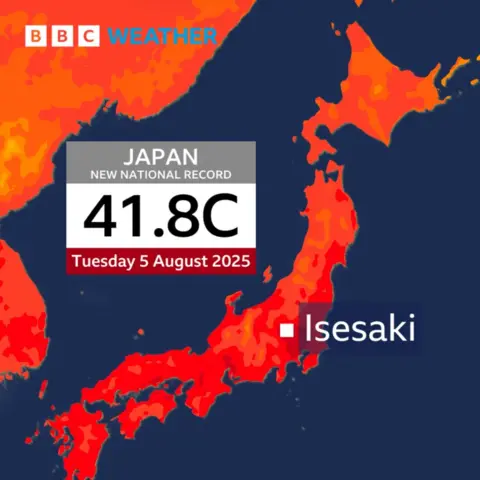BBC News, Singapore
Lead Weather Presenter
 Getty Images
Getty ImagesWhile torrential rains lash China, Hong Kong and parts of India, sweltering heat has enveloped Japan and South Korea as extreme weather claims hundreds of lives in the region.
Climate change has made weather extremities more intense, frequent and unpredictable, scientists say.
This pattern is especially pronounced in Asia, which according to the World Meteorological Organization is warming nearly twice as fast as the global average.
The region has lost $2 trillion (£1.5 trillion) to extreme weather – from floods to heatwaves and droughts – over the past three decades, according to the annual Climate Risk Index survey.
Record heat
Japan marked its hottest day on record on Tuesday, with 41.8C (107F) registered in Isesaki city, Gunma prefecture.
The country had also experienced its hottest-ever June and July this year.
Fifty-six people are believed to have died from heatstroke between mid-June and the end of July, Tokyo’s medical examiner’s office said earlier this week.

Authorities have suspended some train services over concerns that the heat could warp or deform the rails.
“I’m really concerned about global warming, but when it comes to my daily life, I can’t live without turning on the air conditioner,” an office worker in Japan told AFP news.
“I don’t really know what I should be doing, I’m just desperately getting through each day.”
This intense heat is expected to ease a little in the coming days, with some parts of Japan expected to see as much as 200mm of rain in the coming days.
This rain and briefly cooler air will allow some relief from the swelter.
South Korea marked a record streak of 22 “tropical nights” in July where temperatures exceeded 25C.
Last month, the country’s emergency services also reported a surge in calls about heat-related illnesses.
Government agencies and workplaces have relaxed their dress codes to help employees work more comfortably and reduce dependence on air conditioning amid the heat.
Parts of Vietnam are also baking in unprecedented heat, with Hanoi recording its first-ever August day above 40C. The capital city has turned into “a pan on fire” in the last few days, Nam, a construction worker, told AFP.
Storm season
It’s a different picture in China, where floods across the country, from Shanghai to Beijing, have killed many in recent weeks.
Southern China has been battered by heavy rain, and on Wednesday emergency workers raced to clear debris as the region braced for more landslides and floods.
Hundreds of flights were cancelled or delayed in Guangzhou, the capital of Guangdong province. The flooded streets are threatening to worsen an outbreak of the mosquito-borne chikungunya virus in the province.
Such rains are frequent in southern China at this time of the year, but have been enhanced further by tropical storm activity – more especially in the last month.
Just last week, there were three active storms in the west Pacific, whilst prior to June, tropical storm activity was almost non-existent.
Mountainous districts of the capital Beijng late last month were hit by deadly floods late last month which killed dozens including 31 residents in an eldercare home.
Heavy rains are especially deadly in mountainous areas prone to landslides and densely populated areas, where flash floods often catch residents off-guard.
More than 100 people are missing in the northern Indian state of Uttarakhand after a cloudburst – an extreme, sudden downpour of rain over a small area – triggered flash floods.
In Pakistan, nearly 300 people, including more than 100 children, have died in rain-related incidents since June. The deluge has also destroyed hundreds of homes and buildings – at least a quarter of schools in the Punjab province have been partially or completely damaged, according to British aid agency Save the Children.
Tuesday also brought more than 350mm of rain to Hong Kong, which reports say makes it the city’s wettest August day since 1884.
For context, Hong Kong gets about 2400mm a year, most of which falls in summer between June and August.





